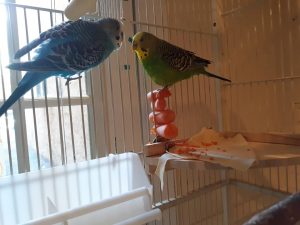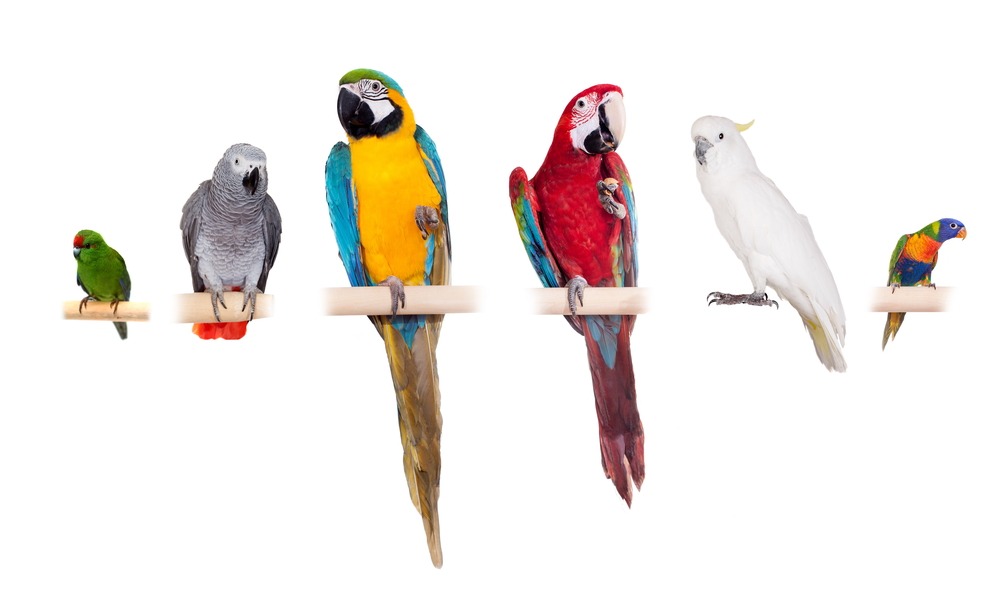Let’s have a little “bird talk” with Erin Doherty. Erin’s committed to the health of her birds and shares how she keeps them healthy and happy. This article was created from our interview.
Birds as companions
When she got the parakeets, Erin didn’t know anything about birds. She’s been learning about how to care for her birds for 16 years.
Erin doesn’t want other people to make the mistakes she made. She hopes we’ll be good guardians of our birds.
Keep a beginner’s mind
We can’t stop learning and say, “Oh, I know enough now.” That’s because there are always new discoveries. Keep that hunger for knowledge to do better for the birds.
Bird talk on introducing a new bird – Quarantine cages
When you introduce a new bird, quarantine them for the first two months in a separate cage. Get them veterinarian checked. Include a Gram Stain to find and clear bacterial infections before they’re introduced to the flock.
Bird talk on nutrition
Nutrition is a big part of keeping birds healthy. Cook vegetables for your birds. Sweet potatoes are good; dark leafy greens are super important. But try to stay organic. Make them a salad mash called chop! You might also give them probiotics; look for human grade whenever you can.
According to Live Science, “Parrots are omnivores, which means that they can eat both meat and vegetation. Most parrots eat a diet that contains nuts, flowers, fruit, buds, seeds and insects. Seeds are their favorite food. They have strong jaws that allow them to snap open nutshells to get to the seed that’s inside. [Some] use their longer beaks to dig insects out of the ground for a meal, and [others] chew on vegetation and drink the juices.”
Feed seeds, but not all seeds. Balance seeds with fresh foods and pellets without dye. Erin dialed down her birds’ seed consumption for weight maintenance.
Consider adding Turmeric to brown rice because it’s anti-inflammatory. For more information, read Toss in More Turmeric.
Phoenix Landing is a great resource
Check out Phoenix Landing. This non-profit is dedicated to the health and happiness of parrots, parakeets, cockatiels, cockatoos and macaws, etc. Read their great information on nutrition for the parrot family. Check out their cookbook, Nourish to Flourish.
Bird talk on enrichment
Music
Birds feel music in their whole body. Believe or not, they can feel vibrations in their feet. Erin feels that music calms her birds down. They like the classical music and Latin music. Try it!
Flight is who they are
Birds’ brains are very connected to their flight apparatus. It’s something they need to do. Erin says, “It’s very whole-body, whole-mind, holistic kind of thing for them to fly.”
An IAABC Journal article shares that parrots in the wild may fly 35-40 miles in an hour. Simply walking around and climbing is not enough for our birds. Read the article Birds Need to Fly, for some thoughtful ways to give your birds the chance to fly.
Bird talk on free flight time and cage time
Let your birds out of their cages during the day, except when people are coming and going or you’re doing something that scares them (vacuuming). But don’t let them outside – they’re not wild! Close toilet lids so they don’t drown.
Put your birds in their cage and close it while you’re sleeping so they are safe. The cage is their home so there’s no problem getting them back there at night. It’s not a prison.
Bird talk on wild birds
Many inside birds love to watch the birds outside, like mourning doves. So if you can, open a window (as long as there’s a screen and it’s warm enough). Your birds will not only enjoy fresh air, but also the sounds of the visiting birds outside.
Carrot forests
 In addition to toys, create a baby carrot forest – hang them from the top of the cage and the side of the bars. They love to shred the carrots. It’s amazing!
In addition to toys, create a baby carrot forest – hang them from the top of the cage and the side of the bars. They love to shred the carrots. It’s amazing!
Kale, parsley in a bath
Break off organic kale or organic parsley stems in a little shallow glass with filtered. Use a clear dish like a glass pie plate because they need to see how deep it is. They won’t get in a dark opaque dish because they don’t know how deep it is and don’t want to drown.
Put the dish on the top of the cage and watch them play!
Watch the interview with Erin to hear more about:
- Essential oils and hydrosols
- Energy healing
- What to expect when you bring home a bird from the shelter
- Keeping birds comfortable in the winter
Erin Doherty
 Erin Doherty is the guardian for four parakeets she brought home from an animal shelter. She is a graduate of Maribeth’s UConnect Animal Communication class. Erin is an intuitive animal healer. She helps parakeet guardians improve nutrition to mitigate tumors in flight-challenged parakeets. Her goal is to restore mobility and harmony to the whole flock.
Erin Doherty is the guardian for four parakeets she brought home from an animal shelter. She is a graduate of Maribeth’s UConnect Animal Communication class. Erin is an intuitive animal healer. She helps parakeet guardians improve nutrition to mitigate tumors in flight-challenged parakeets. Her goal is to restore mobility and harmony to the whole flock.
Erin will receive her Reiki master certification in June 2021 from Four Directions Wellness in Northern Virginia. Erin has taken some online veterinary technician courses through Penn Foster College. She is currently developing her website, yourheartlightreiki.com.
Interested in the UConnect Animal Communication class?

